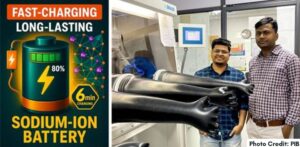As India accelerates toward an electrified, sustainable future a scientific breakthrough from Bengaluru is positioning the country as a global leader in next-generation energy storage. At the heart of this green revolution lies a humble yet powerful element: sodium.

Breaking Free from Lithium: A New Era of Battery Innovation
The race to decarbonize transportation, power grids, and off-grid communities has placed enormous pressure on battery technology. While lithium-ion batteries have powered much of the electric age so far, their rising costs, environmental concerns, and supply chain vulnerabilities particularly their dependence on imports from resource-rich regions like China and South America have triggered a global search for alternatives.
Now a team of researchers at the Jawaharlal Nehru Centre for Advanced Scientific Research (JNCASR), under the Department of Science and Technology (DST), has delivered a major scientific milestone: a high-performance sodium-ion battery (SIB) capable of fast charging, long durability, and safer operation.
Inside the Innovation Fast-Charging, Long-Lasting Sodium-Ion Batteries
Led by Prof. Premkumar Senguttuvan and Ph.D. scholar Biplab Patra, the JNCASR team has developed a sodium-ion battery that charges up to 80% in just six minutes outpacing many premium lithium-ion models. Even more remarkably, the battery has completed more than 3,000 charge cycles, demonstrating both resilience and longevity.
This leap forward was made possible through three key technological enhancements to the anode material:
- Nanoscaling of particles to boost surface area and improve ion mobility
- A carbon coating that stabilizes and enhances electrical conductivity
- Aluminium doping that increases the battery’s speed and structural integrity
The cathode and anode are built using NASICON-type materials (sodium super ionic conductors), allowing for swift and safe sodium-ion migration, with minimal overheating or fire risk.
Why Sodium? Abundant, Safe, and Homegrown
Sodium is not only cheaper and safer than lithium but also widely available in India from sea salt, clay, and other common minerals. Unlike lithium, sodium does not require environmentally harmful mining practices and is not tied to volatile international markets. This gives India a strategic edge in battery self-reliance under its Atmanirbhar Bharat (Self-Reliant India) initiative.
The safety factor is critical: sodium-ion batteries are less prone to combustion, making them ideal for consumer electronics electric vehicles (EVs), and home energy systems, especially in high-temperature or low-maintenance settings.
Impact Across Sectors: From Cars to Countryside
The applications of this sodium-based breakthrough are immense. These affordable, durable, and fast-charging batteries could power:
- Electric vehicles (EVs) across urban and rural India
- Grid-scale renewable energy storage for solar and wind
- Off-grid power solutions in remote villages
- Household backup systems in disaster-prone zones
- Drones, telecom towers, and other mobility and infrastructure tech
India rural and low-income areas, which often suffer from unreliable energy access, stand to benefit the most. With lithium-ion options often too costly or unsafe, sodium-ion alternatives could democratize clean energy access nationwide.
Tested, Validated, and Ready for Scale
The JNCASR team has subjected the battery to rigorous electrochemical cycling and atomic-scale simulations. These tests have confirmed the battery’s real-world performance and helped refine its design.
Though not yet commercially available, the innovation has already attracted attention from industry playersbattery manufacturers, and policymakers. Partnerships, government grants, and investments will be essential to scale production and establish supply chains.
India Global Moment in Clean Tech
This sodium-ion innovation puts India at the forefront of green energy research and materials science. As countries seek alternatives to costly, unstable lithium supplies, India’s breakthrough could become a global export not just of hardware, but of energy independence.
With sustained government backing, international collaboration and alignment with India’s clean energy goals, sodium-ion batteries could soon revolutionize energy storage not just domestically but worldwide.
What Comes Next: A Roadmap to Mass Adoption
- To transition from lab to factory, the following steps are critical:
- Building public-private partnerships to commercialize the technology
- Investing in scalable battery manufacturing infrastructure
- Creating market demand through subsidies or pilot programs in EV and rural electrification sectors
- Developing recycling frameworks and sodium-sourcing guidelines
As nations compete to dominate the green tech future India sodium battery innovation offers a viable, scalable, and affordable path toward energy equity. The promise is clear clean energy that’s made in India, for India and for the world.
